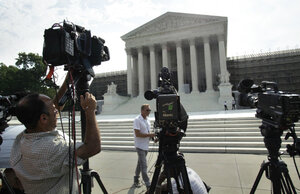A more divisive, political US Supreme Court? Think again.
Public approval of the US Supreme Court is dropping. That trend may be enforced by its decisions on the Arizona immigration law and health-care reform. But the rate of dissent in the court today is no greater than before. The problem lies with the divisive cases the court selects.

Members of the media gather in front of the US Supreme Court June 25 in anticipation of big decisions on Arizona's immigration law and President Obama's health-care reform, also known as Obamacare. Op-ed contributor Kurt Kastorf writes: 'Perhaps the court’s best bet to regain its stature is to be a bit more boring.'
Yuri Gripas/Reuters
Washington
In a week when the Supreme Court hands down potentially divisive decisions on the health-care reform law known as Obamacare and the Arizona immigration law (SB1070), it’s time to set the record straight about a court perceived as extraordinarily divisive and political.
Twenty-five years ago, two-thirds of Americans approved of the way the Supreme Court was doing its job. Today, according to a recent New York Times-CBS News poll, that number is just 44 percent. Pundits will be quick to react to the poll by declaring that public dissatisfaction with the court is a consequence of the Supreme Court’s increasingly partisan and divisive behavior. The Times poll suggests that a majority of the public accepts this explanation as well; 3 out of 4 Americans believe Supreme Court justices are sometimes influenced by their personal and political beliefs.
But are today’s justices any more driven by politics than those of the past?
Exhibit #1 in favor of that view, say the pundits, is the modern trend toward the Supreme Court issuing split decisions, with the justices in the minority writing scathing dissents in every case. The problem with this bit of evidence is that no such trend exists. In fact, the rate of disagreement among Supreme Court justices has been remarkably stable for decades.
The percentage of votes cast as dissents in each judicial term has remained the same during the post-war period – 18.24 percent from 1946 to 2010, and 18.44 percent under today’s Chief Justice John Roberts.
Nor are dissents increasingly along partisan lines. In 1946, every justice was appointed by a Democratic president. Yet the court had the same rate of dissent that year as it has had under Chief Justice Roberts. One also has to question 5-4 decisions as a yardstick of contentiousness. For example, among four of the most contentious cases in American history (Dredd Scott v. Sanford, Korematsu v. United States, Miranda v. Arizona, and Roe v. Wade), none were decided 5-4.
It is not ideology that’s driving the dissent rate, but case selection. Justices throughout history have sought to hear difficult issues, the ones so tricky that they divide the courts of appeal. If an opinion is destined to be affirmed 9-0, the justices are unlikely to hear it.
What is more, litigants probably will not bring such an easy case in the first place. Lawyers, at least the smarter ones, understand what sort of argument a particular set of justices will entertain, and tailor their cases accordingly. Additionally, an increasingly litigious and polarized citizenry sends these cases up the judicial pipeline.
The result is that even if the next president were fortunate enough to appoint all nine Supreme Court justices, the court would keep on producing 5-4 opinions. The cases would simply address a different set of issues that divides the new crop of justices.
So what can the Supreme Court do about its declining approval rating, which is not merely a matter of image but of public confidence in the country’s judicial branch?
When John Roberts became chief justice, he pledged to craft narrow, unanimous opinions whenever possible. Occasionally, he has succeeded in this effort. Last week, the court overturned sanctions that the Federal Communications Commission levied against several television networks. It did so in a unanimous ruling on narrow procedural grounds that avoided a larger debate over free speech and obscenity. But both history and recent experience tell us that a systematic effort to reduce dissent is unlikely to succeed.
Perhaps the court’s best bet to regain its stature is to be a bit more boring.
Studies consistently show that citizens, intentionally or otherwise, view the Supreme Court as legitimate when the Court agrees with citizens’ own ideological preferences, and illegitimate when the court reaches a contrary conclusion. Each time the court decides a hotly debated and deeply divided social issue, half of America loses a bit of respect for the court.
But most difficult legal issues do not raise the public’s ire one way or another. The current Supreme Court hears fewer cases than any court in recent memory. The chief justice has suggested that the reason is a lack of quality cases, but few lawyers and even fewer appellate judges agree. They see numerous legal issues, hotly debated among lawyers and academics, but of little interest to the general public, where guidance from the Supreme Court is badly needed.
Perhaps if the justices spent a few terms focusing more time on civil procedure and evidentiary issues and less on health care and election law, the public’s skepticism over the court’s job performance would begin to dissipate.
Kurt G. Kastorf is an appellate attorney for the United States Department of Justice and a former federal appellate clerk. The views here are his own, and do not necessarily reflect those of the Department of Justice.

